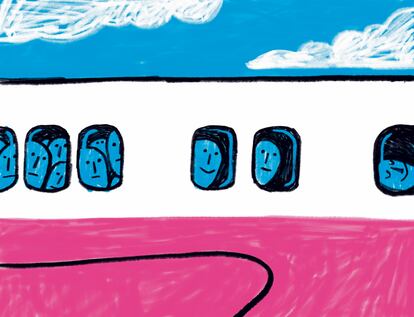The success of premium economy class: How airlines are gentrifying the sky
In the aftermath of the pandemic, airlines rushed to promote a new space on their aircraft, a step up from economy class, promising comfort at reasonable fares. This translation of the desires of the aspirational middle class into the space between seats and the in-flight menu has been a hit

Have you heard of economy class syndrome? It is well documented that, on long-haul flights and in conditions of forced immobility in confined spaces, one passenger in a thousand on commercial flights suffers symptoms of deep vein thrombosis, a potentially serious condition.
To combat it, in the first decade of this century, airlines began to offer 15 to 30 centimeters of extra space between seats, the difference between claustrophobic crampedness and full comfort for anyone willing to pay a little more money. You read that right. Not a little more space for everyone by default, but rather a discretionary improvement in the healthiness of the flight for a new high-flying middle class, those who could not (or did not want to) buy a business or first-class ticket, but rather a slightly higher fare to get rid of the cramped conditions of economy.
Today we know that this commercial maneuver of questionable morality was the precursor of the premium economy class, which has become increasingly popular after the rigors of the pandemic. Mac Schwerin warned of this phenomenon in an incisive article in The Atlantic magazine. In it, Schwerin stated: “Most of us find it especially annoying to be confined to the hell of mediocrity and discomfort that is the main cabin of a Boeing 737.” Check-in and boarding procedures that take forever, the agony of finding that our carry-on luggage exceeds the acceptable cabin dimensions by an inch, the exasperating narrowness of the cubicle in which we will be sitting for the next 8, 10, 12 hours of our lives, the lack of a toiletry kit...
We would all like to move to that low-cost paradise where all of the above disappears in one fell swoop and the chef’s delicacies, a wide range of craft beers and VIP leisure offerings appear on the horizon. In just a couple of sentences, Uzma Khan, a professor of marketing at the University of Miami, sums up the calculation that led the airlines to create and generalize this increasingly profitable intermediate step that is premium economy: “They thought of it as a real estate business, since they were renting plots of land in the air. And [they considered] the size of those plots was as valuable a commodity as square meters in the center of cities as dense and expensive as Paris, New York or London.” And once they had explored the niche and found that there were legions of passengers willing to occupy it, they began to systematize the strategy and offer increasingly more additional details until they consolidated commercial aviation with three types of passengers: the absolute elite, the vulgar and a new aspirational middle class.
Becky Pokora, the editor of the international edition of Forbes magazine, explains that intermediate fares are proliferating “in a very particular context.” During the pandemic, people stopped flying, and when they resumed that more or less daily activity after restrictions and lockdown, they discovered that “they actually hate flying” because it is an “uncomfortable, stressful” experience that makes us feel “like members of a herd.” Given that business class flights usually cost three to five times as much as ordinary flights, paying 40% to 75% more for a good substitute—that middle cabin with priority boarding, spacious cubicles with a reclining seat, footrest and headrest, gourmet menu, welcome cocktail, touchscreen with extensive audiovisual entertainment, pillow and duvet, eye mask and earplugs—is a very attractive option.
Pokora offers a comparative analysis of the flight conditions in the three available classes and concludes that the premium option is becoming increasingly attractive to a significant proportion of customers and is undoubtedly very profitable for the airlines. Although the major pioneers in this process of gradual gentrification have been companies with a penchant for luxury, such as Emirates Airlines, almost all of them — British Airways, Delta Air Lines, Air France, Iberia, Cathay Pacific, Virgin, Qantas and Lufthansa — have been happily participating in squaring the circle. Many of these companies’ advertisements are focusing on how their plus or premium options are getting closer and closer to the executive “experience” at a much lower price. Once again, the middle class is gaining access to paradise.
Nevertheless, critical voices such as Vox’s Whizy Kim point out that, given the current market circumstances, many airlines may find it “tempting” to tolerate a general deterioration in basic flight conditions so that more and more users will be inclined to dig deeper into their pockets. In her opinion, that is already happening. Kim cites recent studies pointing to a general drop in the satisfaction rate of U.S. airline customers. Has the pandemic somehow exacerbated their taste for quality of life and their intolerance of stress and discomfort? Or can we conclude that the experience of flying economy is now less satisfying than ever?
Jessica Puckett of Traveler magazine was among the first to ask why everyone has suddenly taken to flying premium options. Her answer could not have been more eloquent: “Because a gulf has opened up, in terms of luxury, customer service and comfort, between ordinary economy and upgraded. And everyone who can afford it prefers to cross the divide and separate themselves from the vulgar, if only to avoid landing at their destination with a deep vein thrombosis.”
Sign up for our weekly newsletter to get more English-language news coverage from EL PAÍS USA Edition
Tu suscripción se está usando en otro dispositivo
¿Quieres añadir otro usuario a tu suscripción?
Si continúas leyendo en este dispositivo, no se podrá leer en el otro.
FlechaTu suscripción se está usando en otro dispositivo y solo puedes acceder a EL PAÍS desde un dispositivo a la vez.
Si quieres compartir tu cuenta, cambia tu suscripción a la modalidad Premium, así podrás añadir otro usuario. Cada uno accederá con su propia cuenta de email, lo que os permitirá personalizar vuestra experiencia en EL PAÍS.
¿Tienes una suscripción de empresa? Accede aquí para contratar más cuentas.
En el caso de no saber quién está usando tu cuenta, te recomendamos cambiar tu contraseña aquí.
Si decides continuar compartiendo tu cuenta, este mensaje se mostrará en tu dispositivo y en el de la otra persona que está usando tu cuenta de forma indefinida, afectando a tu experiencia de lectura. Puedes consultar aquí los términos y condiciones de la suscripción digital.
More information
Últimas noticias
Most viewed
- Sinaloa Cartel war is taking its toll on Los Chapitos
- Oona Chaplin: ‘I told James Cameron that I was living in a treehouse and starting a permaculture project with a friend’
- Reinhard Genzel, Nobel laureate in physics: ‘One-minute videos will never give you the truth’
- Why the price of coffee has skyrocketed: from Brazilian plantations to specialty coffee houses
- Silver prices are going crazy: This is what’s fueling the rally











































